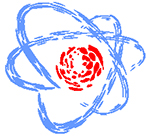Speaker
Dr
Roman Eremin
(Samara Center for Theoretical Materials Science, Samara University)
Description
A step-by-step procedure of searching for independent atomic configurations and their modeling by means of density functional theory (DFT) is developed for the title compound. First, the inequivalent (totally 87) configurations of LiNiO2 (2x2x1 modeling supercell) were selected with respect to content and arrangement of Li-ions and relaxed using a number of the DFT models. Next, the obtained LiNiO2 configurations were used for sampling of the doped LiNi10/12Co1/12Al1/12O2 (NCA) cathode configurational space (totally 11484 structures). The DFT relaxation was repeated within the most efficient DFT models from the point of view of the observed time consumption.
The relaxed entries of the NCA configurational space, as well as their energies and statistical weights were used for modeling behavior of the crystal structure lattice parameters and their comparison with the dependencies observed by means of operando neutron diffraction during charge/discharge cycles. The experiments were carried out at High Resolution Fourier Diffractometer (IBR-2, Frank Laboratory of Neutron Physics). At the next stage of analysis, the Grimme DFT-D3 method as implemented in the VASP program was applied to account dispersion interaction for the system under investigation. The obtained results for extended model have been found in a good correlation with the experimental data.
The proposed approach for investigation of the configurational space of cathode material allows one to study thermodynamics and structural stability of cathode materials with an appropriate complexity of the configurational space taking into account possible disordering. Furthermore, a possibility of joint use of the modeling approaches and machine learning algorithms can reduce computational complexity of a complement approach significantly and, consequently, increase its properties prediction ability with respect to dopant species and contents.
We are obliged to computational facilities of the Samara University computing complexes ‘Sergey Korolev’ and ‘Zeolite’ (Samara Center for Theoretical Materials Science). The computational studies were supported by the Russian Federation Government (projects No.14.В25.31.0005 and No.3.6588.2017/9.10) and the Russian Foundation for Basic Research (project No.15-43-02194). The work on the neutron diffraction experiments was supported by Russian Science Foundation (project No. 14-12-00896).
Author
Dr
Roman Eremin
(Samara Center for Theoretical Materials Science, Samara University)
Co-authors
Dr
Ivan Bobrikov
(JINR)
Mr
Pavel Zolotarev
(SCTMS)

